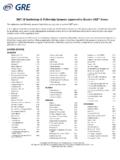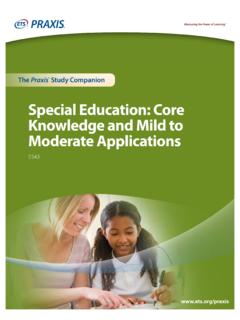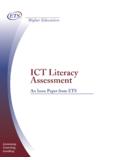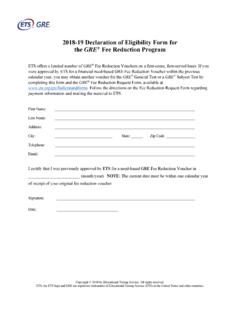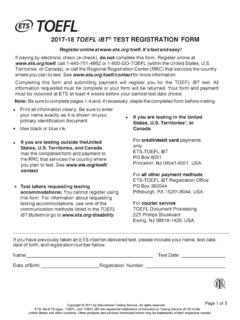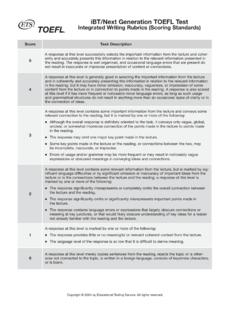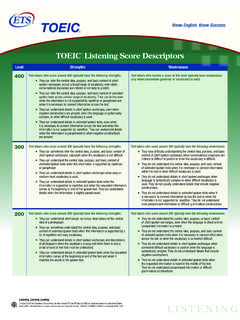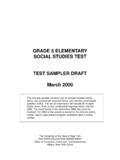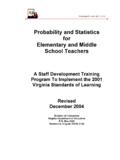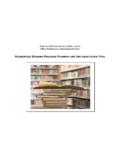Transcription of Teaching Reading: Elementary Education - ETS Home
1 Teaching reading : Elementary Education Praxis Study Companion2 The Praxis Study CompanionWelcome to the Praxis Study CompanionWelcome to the Praxis Study Companion Prepare to Show What You KnowYou have been working to acquire the knowledge and skills you need for your Teaching career. Now you are ready to demonstrate your abilities by taking a Praxis test. Using the Praxis Study Companion is a smart way to prepare for the test so you can do your best on test day. This guide can help keep you on track and make the most efficient use of your study Study Companion contains practical information and helpful tools, including: An overview of the Praxis tests Specific information on the Praxis test you are taking A template study plan Study topics Practice questions and explanations of correct answers Test-taking tips and strategies Frequently asked questions Links to more detailed informationSo where should you start?
2 Begin by reviewing this guide in its entirety and note those sections that you need to revisit. Then you can create your own personalized study plan and schedule based on your individual needs and how much time you have before test in mind that study habits are individual. There are many different ways to successfully prepare for your test. Some people study better on their own, while others prefer a group dynamic. You may have more energy early in the day, but another test taker may concentrate better in the evening. So use this guide to develop the approach that works best for Teaching career begins with preparation. Good luck!Know What to ExpectWhich tests should I take? Each state or agency that uses the Praxis tests sets its own requirements for which test or tests you must take for the Teaching area you wish to you register for a test, confirm your state or agency s testing requirements at are the Praxis tests given?
3 Praxis tests are given on computer. Other formats are available for test takers approved for accommodations (see page 37).3 The Praxis Study CompanionWelcome to the Praxis Study CompanionWhat should I expect when taking the test on computer?When taking the test on computer, you can expect to be asked to provide proper identification at the test center. Once admitted, you will be given the opportunity to learn how the computer interface works (how to answer questions, how to skip questions, how to go back to questions you skipped, etc.) before the testing time begins. Watch the What to Expect on Test Day video to see what the experience is and when are the Praxis tests offered?You can select the test center that is most convenient for you. The Praxis tests are administered through an international network of test centers, which includes Prometric Testing Centers, some universities, and other locations throughout the schedules may differ, so see the Praxis web site for more detailed test registration information at The Praxis Study Companion4 Table of ContentsTable of ContentsThe Praxis Study Companion guides you through the steps to success1.
4 Learn About Your Test ..5 Learn about the specific test you will be taking2. Familiarize Yourself with Test Questions ..9 Become comfortable with the types of questions you ll find on the Praxis tests3. Practice with Sample Test Questions ..13 Answer practice questions and find explanations for correct answers4. Determine Your Strategy for Success ..24 Set clear goals and deadlines so your test preparation is focused and efficient5. Develop Your Study Plan ..27 Develop a personalized study plan and schedule6. Review Study Topics ..31 Review study topics with questions for discussion7. Review Smart Tips for Success ..35 Follow test-taking tips developed by experts8. Check on Testing Accommodations ..37 See if you qualify for accommodations that may make it easier to take the Praxis test9.
5 Do Your Best on Test Day ..38 Get ready for test day so you will be calm and confident10. Understand Your Scores ..40 Understand how tests are scored and how to interpret your test scoresAppendix: Other Questions You May Have ..42 The Praxis Study Companion5 Step 1: Learn About Your Test1. Learn About Your TestLearn about the specific test you will be takingTeaching reading : Elementary Education (5203)Test at a GlanceTest Name Teaching reading : Elementary EducationTest Code 5203 Time hoursNumber of Questions 90 selected-response (SR) questions, 3 constructed-response (CR) questionsFormat The selected-response questions account for approximately 75% of the total test score. The constructed-response questions account for approximately 25% of the score.
6 This test may include questions with an audio or video Delivery Computer delivered Approximate Approximate Number of Percentage of Content Categories Questions Examination I. Assessment and Diagnostic Teaching of 22 SR and 1CR* 27% reading II. reading Development 45 SR and 1CR* 46% A. Phonemic Awareness and Oral Language Development B. Phonics and Alphabetic Principle C. Word-Analysis Skills and Vocabulary Development D. Development of reading Fluency and reading Comprehension E. reading Comprehension Strategies Across Text Types III. Writing in Support of reading 23 SR and 1CR* 27% A. Interdependence of reading and Writing Development B.
7 reading and Writing as Tools for Inquiry and Research * On your score report, points earned on the CR questions are reported separately from points earned on the SR Praxis Study Companion6 Step 1: Learn About Your TestAbout This TestThe Praxis Teaching reading : Elementary Education test focuses on the knowledge and skills a teacher must have to support reading development at the Elementary level. It reflects the five essential components of effective reading instruction as identified by the National reading Panel: phonemic awareness, phonics, fluency, vocabulary, and comprehension, along with other foundational reading skills students must develop, such as word recognition and the application of print concepts. In addition, the test assesses the individual s knowledge of how to support developing literacy as an integrated skill, starting with oral language development and building to include developing writing skills in parallel with reading questions call on the individual s knowledge of research-based reading practices as well as the ability to apply knowledge and principles to instructional situations.
8 The test taker will be required to analyze and respond to situations involving both classes and individual students at the grade levels from kindergarten through grade six, including students with diverse addition to selected-response questions, the test contains three constructed-response questions designed to elicit an individual s understanding in the areas of assessment and diagnostic Teaching , reading development, and writing in support of test may contain some questions that will not count toward your SpecificationsTest specifications in this chapter describe the knowledge and skills measured by the test. Study topics to help you prepare to answer test questions can be found on page Assessment and Diagnostic Teaching of Reading1.
9 Knows a range of formal and informal reading assessments2. Knows how different types of assessment data are used to diagnose the reading needs and monitor the progress of individual students3. Knows how diagnostic reading data are used to differentiate instruction to address the needs of students with reading difficulties4. Knows how diagnostic reading data are used to differentiate instruction to accelerate the development of students reading skills5. Knows the purposes of flexible grouping in addressing students changing reading needs ( , academic skills, interests, learning styles)6. Is familiar with the Response to Intervention (RTI) processII. reading DevelopmentA. Phonemic Awareness and Oral Language Development1. Knows a variety of instructional strategies for developing students listening and speaking skills2.
10 Knows a variety of instructional strategies for expanding students listening and speaking vocabularies3. Is familiar with methods for scaffolding the learning of Standard American English by speakers of other languages and dialects4. Is familiar with age-appropriate milestones for language development5. Knows how to create a learning environment that is respectful of, and responsive to, linguistic and cultural diversity6. Understands the roles of phonemic awareness in reading development7. Knows a variety of instructional strategies to promote development of phonemic-awareness skillsThe Praxis Study Companion7 Step 1: Learn About Your TestB. Phonics and Alphabetic Principle1. Knows ways to promote students automatic recognition of high-frequency sight words 2.
